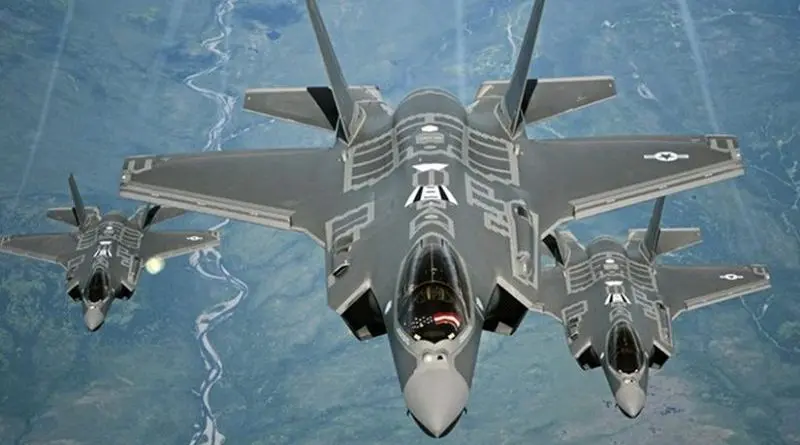The US Set To Make Nuclear War More Likely – OpEd
The US is about to move towards a far more likely first use of nuclear weapons, with word that the Air Force has “completed flight testing” of the cost-and-performance-plagued F35A Lightning fighter, all units of which are being “upgraded” to carry thermonuclear weapons.
What this means, as explained in a new article in Popular Mechanics, is that the world’s most costly weapons program (at $1.7 trillion), a fifth-generation fighter, supposedly “invisible” to radar (that actually cannot fight and is not invisible to advanced radars), now has a new mission to justify its existence and continued production: dropping dial-able “tactical” nuclear weapons that can be as small as 0.3 kilotons or up to 50 kilotons in explosive power.
Now 0.3 kilotons is “just” the equivalent of 300 tons of dynamite, which supposedly makes them “useable,” meaning not holocaust-causing (that is assuming that some country backing the targeted country doesn’t decide to respond in kind and we go up the escalation ladder quickly to ever bigger bombs. Meanwhile, \ dialed up to its maximum 50-kiloton power each F35A bomb would be significantly more than twice as powerful as the nuclear bomb that leveled Nagasaki.
The Popular Mechanics article, also published in Yahoo News, quotes Pentagon sources as saying the new F35A capability gives the US flexibility to deliver nukes to targets in a country threatening the US, and also to recall them up to the last second before dropping the weapon since the plane would be piloted. But this supposed advantage of a manned delivery system being recallable is a fantasy.
As Daniel Ellsberg has exposed in detail in his 2017 book The Doomsday Machine, written based on his decades of work with a top security clearance on behalf of the Secretary of Defense office investigating command-and-control procedures and practices of the nation’s nuclear forces, there is no way to guarantee that a pilot ordered on a nuclear strike mission will receive — or believe — any message or signal ordering a cancellation of the attack order.
As Ellsberg explains, communication systems routinely break down on an almost daily basis at one of the US military’s hundreds of global bases and aircraft carrier battle groups. cutting of the link between Washington and bases far-flung military bases, because of equipment malfunctions, storms, solar flares, etc.. Furthermore, in a period of international crisis, a pilot may distrust even an order to call off an attack which, after all, won’t be a phone call from the president, a Pentagon general, or even a known base commander, but rather a short coded signal. As Ellsberg notes in his terrifying book, the other flaw is that a pilot, once ordered on such a mission, could decide in the heat of the moment, to just carry on with orders and drop his weapon regardless of receiving a cancellation order. Remember, in times of crisis, countries may be employing jamming systems to knock out enemy military communications, or could even be blinding communication satellites.
Meanwhile the scenario presented in the article — a lone pilot being dispatched to deliver one or two dial-able B61-12 thermonuclear weapons onto some command-and-control center or missile launching site, perhaps — is not really what the Pentagon strategists have in mind for its F-35A planes.
Actually, hundreds of these Air Force versions of the F-35 have been getting so-called “block four’ alterations, with bulging farings replacing their formerly sleek bodies, in order to allow the carrying of two elongated Hydrogen bombs inside their fuselages, where they won’t present a larger radar image as bombs carried externally under wings would do. These re-configured planes, which also have software upgrades to allow them to prime, unlock and release their twin nukes, are being delivered to forward bases near Russia and China within the relatively short range of the bomb-laden planes.
The idea (hopefully wishful thinking), is that such planes, armed with their two nukes, could streak across a Russian and/or Chinese border at supersonic speed, flying low to the ground, to strike government buildings, military bases, and missile silos in a surprise strike, leaving the target country unable to retaliate.
For US military policy makers, all the way back to the post-war late 1940s, through the 1950s and on, taking out America’s nuclear-armed rivals in a preventive atomic blitz has long been a strategic dream, always deferred thankfully because of lingering fears among saner heads that such a criminal and genocidal attack would fail to prevent a counterattack.
Bernie Sanders, the independent self-described “socialist” senator from Vermont, now needs to finally end his own dogged and cynical support for the basing of 18 F-35A planes at the Burlington International Airport, where pilots of the Vermont Air National Guard are now training for exactly the kinds of bombing scenario described above.
Sanders has insisted that while he “opposes” the “wasteful” F35 program, it is a “done deal” and so he wants Vermont’s Air National Guard unit to get a piece of the “benefits” of having it and the “jobs” it supposedly brings with it in his state. He has continued to dissemble, claiming that the Vermont F35As will not carry nuclear weapons or be used in nuclear war. In fact, his office was caught altering a document from the Pentagon to hide the fact that the Vermont Guard’a planes would in fact definitely be upgraded with the “block four” alterations so they can carry nukes just like all F-35As in the Air Force fleet.
Vermont’s planes would not, and could not, fly from Burlington over the North Pole to deliver their bombs to Russian or Chinese targets, except with multiple in-flight refueling sessions, and all the while flying at subsonic speeds to conserve fuel, obviating any chance of a “surprise” attack. But they could, if the pilots are trained (as they will be) in using the upgraded planes to carry their nuclear cargo and to release them on targets, be activated during a period of international crisis. The plan would then be for US-based pilots to ferry their F-35A planes to forward bases, where the nuclear bombs would be stockpiled. The planes and their pilots would then be prepositioned, to join a potential attack, or to create a sense of looming threat that would, supposedly, lead the enemy — say Russia or China — to back down, or alternatively to launch their own attack first.
With word the Air Force is ready to start full-scale upgrading of its F35A fleet to nuclear-capable bombers, Sen. Sanders needs to execute a red-faced volte-face and demand the immediate removal of F35A jets from Vermont. He must also stop hypocritically supporting the further production and Block-Four upgrading of this plane.
Let’s be clear: a nuclear-armed, radar-evading fighter-bomber fleet cannot by any stretch be conceived of as a “retaliatory” weapon. If Russia or China, the only countries that could even conceivably consider launching a first strike on the US, were to do so, having a plane that could hit command-and-control centers, missile silos and military bases in the attacking country would be useless. First of all those planes would have been already blown to smithereens on the ground in the initial enemy attack. Second, if they somehow survived to take off, the national political and military leaders of any country launching such an attack would long since have moved to protective hidden locations once having ordered their attack, troops would have been moved off their inevitably targeted bases with their equipment, and missile silos would be empty holes, their rockets having already been launched. Moreover, enemy countries would be on high alert looking for any incoming F35s or other bombers and would have their anti-aircraft missile arrays ready to fire, and their fighter defenses already in the air on full alert to knock down the heavily burdened and inevitably poorly armed incoming US planes.
It’s all a big lie in other words, for the Pentagon to claim these planes are making the world safer by including a pilot.
As first-strike weapons the nuclear bomb-capable F35A simply increases the chance that a war will be started by the US, if Pentagon strategists start believing they have a window of opportunity to strike without fear of a significant retaliation.
That leaves the other more likely risk too: That this nuclear-capable fighter could be used to deliver a “small nuke” against some non-nuclear nation — one of the many where US military forces are constantly being engaged in undeclared wars like Syria, Iraq, Yemen, Afghanistan, Somalia, Niger, the Philippines, etc. The consequences of such a use of a nuclear weapon against a non-nuclear nation, by opening the door to widespread use of nuclear weapons in virtually any armed conflict, could be as profound as was the first such use against non-nuclear Japan by a cocky US in the waning days of World War II.
Those two bombings of two non-military targets, obliterating two major Japanese cities, led directly to a multi-generational multi-trillion-dollar arms race between the US and Soviet Union, and ultimately China too, and to a spread of nuclear weapons to seven more nations.
This latest escalation of nuclear weaponry, creating a fleet of over a thousand nuclear-carrying stealth fighter-bombers, will inevitably lead to similar planes being developed in Russia, China and elsewhere (China has already created a very similar stealth fighter to the F-35, and Russia, which has a very advanced aircraft design capability, is sure to follow suit). The unrelenting efforts, at incalculable cost. by the US to come up with a viable first-strike capability are also compelling the Russians and Chinese to respond with alternative deterrent weapons, notably hypersonic cruise missiles that can autonomously change direction and shift targets while flying at thousands of miles per hour, are not first-strike weapons, given the relatively longer time it would take them to reach their targets.
For all the huffing and puffing of media scaremongers, the hypersonic missiles being tested by Russia and China are a defensive weapons designed to make a nation like the US that is openly looking for an offensive first-strike possibility, think twice before launching such a holocaust.
Deterrence is decidedly not what the F35A nuclear bomber upgrades are about. The best that can be hoped is that this bomber upgrade is just the latest in a series of schemes by the Pentagon, F35-maker Lockheed-Martin, and all the company’s Congressional backers accepting the company’s bribes, to keep this $1.7-trillion gravy train for this epic boondoggle of a plane flowing.


If there is anyone dreaming of wining a nuclear war is simply an idiot. Once those bombs are released against an opponent, the retaliation will hit within minutes if not seconds. I, as an ordinary human being on this planet, predict, use of Nuclear warhead, we will perish and burn to hell. Hiroshima and Nagasaki, even Chernobyl should be enough to deter use of Nuclear Bombs. I watch NASAs Mars discoveries, if you hadn’t, my advise is; watch what Mars looks like, and imagine the Earth would look the same. I do not worry for my self at 85 years old, I worry for my children, my grandchildren and great grandchildren and beyond. Think, before you push that button.